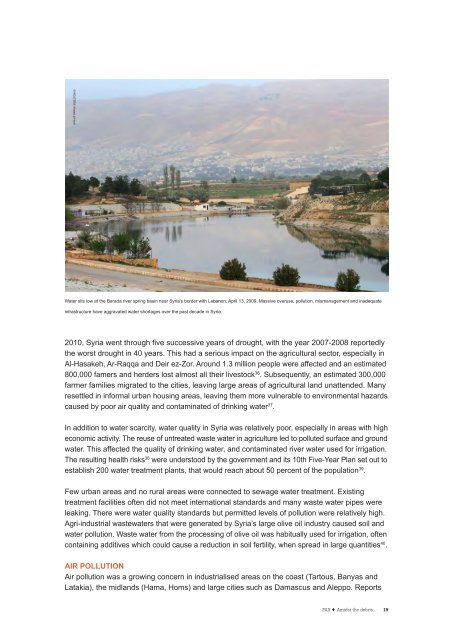Amidst the debris..
pax-report-amidst-the-debris-syria-web
pax-report-amidst-the-debris-syria-web
Create successful ePaper yourself
Turn your PDF publications into a flip-book with our unique Google optimized e-Paper software.
© REUTERS/ Khaled al-Hariri<br />
Water sits low at <strong>the</strong> Barada river spring basin near Syria’s border with Lebanon, April 13, 2009. Massive overuse, pollution, mismanagement and inadequate<br />
infrastructure have aggravated water shortages over <strong>the</strong> past decade in Syria.<br />
2010, Syria went through five successive years of drought, with <strong>the</strong> year 2007-2008 reportedly<br />
<strong>the</strong> worst drought in 40 years. This had a serious impact on <strong>the</strong> agricultural sector, especially in<br />
Al-Hasakeh, Ar-Raqqa and Deir ez-Zor. Around 1.3 million people were affected and an estimated<br />
800,000 famers and herders lost almost all <strong>the</strong>ir livestock 36 . Subsequently, an estimated 300,000<br />
farmer families migrated to <strong>the</strong> cities, leaving large areas of agricultural land unattended. Many<br />
resettled in informal urban housing areas, leaving <strong>the</strong>m more vulnerable to environmental hazards<br />
caused by poor air quality and contaminated of drinking water 37 .<br />
In addition to water scarcity, water quality in Syria was relatively poor, especially in areas with high<br />
economic activity. The reuse of untreated waste water in agriculture led to polluted surface and ground<br />
water. This affected <strong>the</strong> quality of drinking water, and contaminated river water used for irrigation.<br />
The resulting health risks 38 were understood by <strong>the</strong> government and its 10th Five-Year Plan set out to<br />
establish 200 water treatment plants, that would reach about 50 percent of <strong>the</strong> population 39 .<br />
Few urban areas and no rural areas were connected to sewage water treatment. Existing<br />
treatment facilities often did not meet international standards and many waste water pipes were<br />
leaking. There were water quality standards but permitted levels of pollution were relatively high.<br />
Agri-industrial wastewaters that were generated by Syria’s large olive oil industry caused soil and<br />
water pollution. Waste water from <strong>the</strong> processing of olive oil was habitually used for irrigation, often<br />
containing additives which could cause a reduction in soil fertility, when spread in large quantities 40 .<br />
AIR POLLUTION<br />
Air pollution was a growing concern in industrialised areas on <strong>the</strong> coast (Tartous, Banyas and<br />
Latakia), <strong>the</strong> midlands (Hama, Homs) and large cities such as Damascus and Aleppo. Reports<br />
PAX ! <strong>Amidst</strong> <strong>the</strong> <strong>debris</strong>...<br />
19


